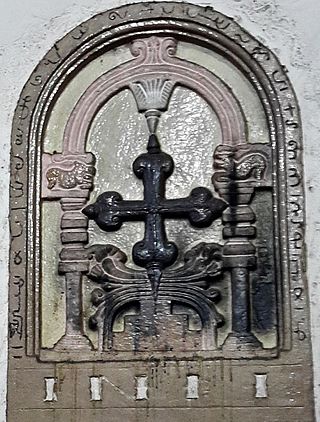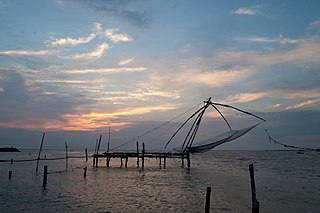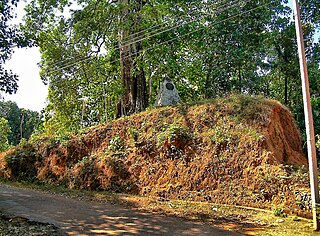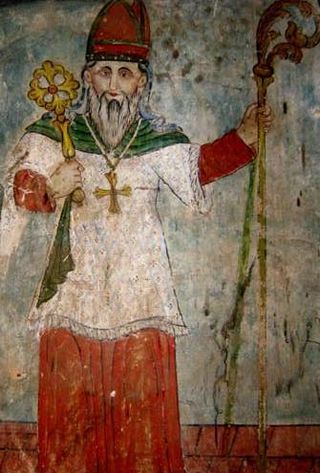Related Research Articles

The Saint Thomas Christians, also called Syrian Christians of India, Marthoma Suriyani Nasrani, Malankara Nasrani, or Nasrani Mappila, are an ethno-religious community of Indian Christians in the state of Kerala, who, for the most part, employ the Eastern and Western liturgical rites of Syriac Christianity. They trace their origins to the evangelistic activity of Thomas the Apostle in the 1st century. The Saint Thomas Christians had been historically a part of the hierarchy of the Church of the East but are now divided into several different Eastern Catholic, Oriental Orthodox, Protestant, and independent bodies, each with their own liturgies and traditions. They are Malayalis and speak Malayalam. Nasrani or Nazarene is a Syriac term for Christians, who were among the first converts to Christianity in the Near East.

The Kingdom of Cochin, named after its capital in the city of Kochi (Cochin), was a kingdom in the central part of present-day Kerala state. It commenced at the early part of the 12th century and continued to rule until 1949, when the monarchy was abolished by the Dominion of India.

Malankara Metropolitan is an ecclesiastical title given to the head of the Malankara Syrian Church.

Saint Francis Church, in Fort Kochi, Kochi, originally built in 1503, is one of the oldest European churches in India and has great historical significance as a witness to the European colonial ambitions in the subcontinent. The Portuguese explorer Vasco da Gama died in Kochi in 1524 when he was on his third visit to India. His body was originally buried in this church, but after fourteen years his remains were moved to Lisbon and now located at Jerónimos Monastery.

The Santa Cruz Cathedral Basilica at Fort Kochi, Kochi, is one of the nine basilicas in Kerala. Counted as one of the heritage edifices of Kerala, this church is one of the finest and most impressive churches in India and visited by tourists the whole year round. It is a place of devotion as well as a center of historic significance, endowed with architectural and artistic grandeur and colours of the Gothic style.

The Mattancherry Palace is a palace popularly known as the Dutch Palace, in Mattancherry, Kochi, in the Indian state of Kerala which features Kerala murals depicting portraits and exhibits of the Rajas of Kochi. The palace was included in the "tentative list" of UNESCO World Heritage Site and hence it's yet to be in UNESCO. Despite the name Dutch Palace, the palace was built by the Portuguese Empire as a gift to the Kingdom of Cochin.

The Malabar Independent Syrian Church (MISC) also known as the Thozhiyur Church, is a Christian church centred in Kerala, India. It is one of the churches of the Saint Thomas Christian community, which traces its origins to the evangelical activity of Thomas the Apostle in the 1st century.

Kochi is a city located in the Ernakulam District in the Indian state of Kerala about 200 km from Trivandrum, the capital of Kerala.

Kunnathur Kesavan Raman Pillai, also known as Raja Kesavadas was the Dewan of Travancore during the reign of Dharma Raja Karthika Thirunal Rama Varma. He is well known for his military tactics and administrative acumen. He was the mastermind in developing the Alappuzha town.

Nedumkotta or Travancore lines was a wall built as a protection against consistent invasions from Mysore during the rule of Tipu Sultan. It was built by the Dharma Raja Karthika Thirunal, King of Travancore, with the request, support and permission of the Kingdom of Kochi. It was constructed by Rama Varma under the supervision of his commander Eustachius De Lannoy. The work was started in 1762 it was completed only by 1775. The lines consist of a ditch about sixteen feet broad and twenty feet deep with a thick bamboo hedge in it, a slight parapet and good rampart and bastions on rising grounds almost flanking each other from one extreme of the lines to the other. The construction of Nedumkotta or the Travancore Lines is considered to be a unique and unparallel episode in Indian History by historians.
Kaimal is an aristocratic title that was historically used by various chiefs from the Nair caste during the feudal period of what is now the Indian state of Kerala. The Kaimals are one of the highest caste of Hindus in Kerala and South India in general. It was the title awarded to notable Samanthan and Kiryathil Nair families. Various families have used the title, including the Kaimals of Koratti, Angi and Koddachery.

Mar Thoma I, also known as Valiya Mar Thoma and Arkkadiyokkon Thoma in Malayalam and Thomas de Campo in Portuguese was the first native-born, popularly-selected Metropolitan bishop of the 17th-century Malankara Church. He was the last Archdeacon of the undivided St. Thomas Christians of Malankara (Maliyankara).
Mar Thoma V was the 5th Malankara Metropolitan from 1728 to 8 May 1765. He was born as Ousep to the Pakalomattom family, one of the oldest families in Kerala. His tenure faced numerous challenges and conflicts with bishops sent from the Syriac Orthodox Patriarchate in Antioch, resulting in some of these Syriac bishops being banished from the country and forced to return.
Mar Thoma IV was the 4th Malankara Metropolitan of the Malankara Church in India, serving from 1688–1728. During his tenure, the church was subject to a number of persecutions.
The Kavalappara is an aristocratic Indian Nair family. In medieval Kerala, they served as part of the landed nobility and were sworn to the service of the rajas of the area, first that of Palghat and then later that of Cochin. Based at Kavalappara Desam in Karakkat, Valluvanada, their holdings extended to areas such as Kailiad and Panayur.
Mar Thoma Residential School (MTRS) is a co-educational institution located at Kuttapuzha, in the town of Tiruvalla, Kerala, India, 1km from the town centre. It is affiliated to the Indian Certificate of Secondary Education and follows the ICSE syllabus. Enrolment is approximately 1600 students with a staff of 70 teachers. The medium of teaching is English. The school has a teachers training institute.

The Saint Thomas Christian denominations are Christian denominations from Kerala, India, which traditionally trace their ultimate origins to the evangelistic activity of Thomas the Apostle in the 1st century. They are also known as "Nasranis" as well. The Syriac term "Nasrani" is still used by St. Thomas Christians in Kerala.

Arohana Marthoma Church is a church situated in Anicadu Village, 5 km from Nedumkunnam and 4 km from Mallappally in Pathanamthitta district in the southern part of Kerala, India. It is a Malankara Mar Thoma Syrian Church under Kottayam- Kochi Dioceses. Arohana Marthoma Church has a total of about 176 families with more than 932 members.
References
- ↑ "Raja Thoma Villarvattam – King of the Nasranis". NSC Network. 15 April 2007. Retrieved 3 July 2009.
- ↑ Aiya, V. Nagam (1999). The Travancore State Manual. Vol. II. Kerala Gazetteers Dept. ISBN 9788185499321.
- ↑ "Kerala Local News | Cochin | Local Features". www.manoramaonline.com. Archived from the original on 24 August 2013.
- ↑ Narayanan, M. G. S. Perumāḷs of Kerala. Thrissur (Kerala): CosmoBooks, 2013. 358.
- ↑ "Indian Churches - History in Malayalam". www.synodofdiamper.com.
- ↑ Bernard, K L (1980). Flashes of Kerala History.
- ↑ Eapan (2021). The Permanent King of Cochin. p. 39.